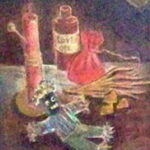Many are familiar with the word “Voodoo”. Whether you’ve seen it in the movies or a cheap novelty imitation of the real thing in a retail store; many are unaware of the true meaning and beliefs associated with this religion.
History: Voodoo originally began under the title of Vodun. The name came about in West Africa around the 18th-19th century. Vodun, unknown to many, translates into the word “spirit”. During the colonial timeframe Vodun was greatly shunned upon, this resulted in many Priests being murdered or imprisoned; some even tortured.
This horrid behavior did not stop those of the Vodun religion from holding onto their beliefs. They would in turn form underground groups to continue their faith and worship their mighty gods. During this duration there were many who traveled afar to places such as Haiti and as time passed, into North America. As this was happening the religion and practices involved with Vodun evolved and began to change. Upon further investigation you will find that each location has slightly different methods to the religion. It is most familiar to find practices of Vodun in locations where Haitian refugees have made a home.
Misinterpretations: Due to the writings in a book titled “Haiti or the Black Republic” written in 1884 there was a poor interpretation of what ‘Voodoo’ was truly about. It spoke of the religion being associated with pure evil and human cannibalism. This led to what is commonly shown in movies when referring to Voodoo. In the 1950’s anthropologists did many studies to reveal accurate information on associations with Vodun or Voodoo.
Another misinterpretation is that Voodoo and Hoodoo are one and the same. This is not the case. Voodoo is a religion which serves their gods, whereas Hoodoo is no more than a magical practice without any association to any form of religion. It is true however that many associated with Voodoo practice Hoodoo and vice versa, however this is not always the case.
Worship: The main traditional focus of Vodun revolves around the God Olorun. Below Olorun is a lesser God by the name of Obatala who created the Earth and all life upon it. In time there was a battle between the two main Gods which eventually led to a temporary banishment of Obatala.
Aside from the religions two main Gods, there are many “minor spirits” as well. A brief list containing only a small amount of them is as follows in alphabetical order:
Agwe – Spirit of the sea
Ayza – The protector
Baka – A dark and evil spirit who will reveal himself in the form of an animal
Baron Samedi – The guardian of the grave
Dambala – The serpent spirit
Ezili / Erzulie – The female spirit of love
Ogou Balanjo – The healing spirit
Ogun – The spirit of war
Sango – The spirit of storms
Rituals: These “ceremonies” are held in order to contact one of the many spirits associated with Vodun. Rituals are commonly performed in a Hounfour which is a Vodun temple. Hollywood has given these rituals a sick and sadistic visual which in many ways is untrue to the real components involved.
Most ritual ceremonies will consist of a large feast followed by a “veve”; this is a pattern or artwork the Loa will draw on the floor. A Loa is an individual similar to a priest or higher individual devoting their life to the religion with the powers of cleansing, healing, and protection to name a few. Dancing is another large part of ceremonies which can be accompanied by the sacrifice of an animal. This animal is usually cooked thereafter and eaten.
I hope by reading this article it has shed some light to a further in depth view of what Vodun / Voodoo is about. As with most religions, this is just scratching the surface as there is so much more to the practice than stated here. For more helpful information you may want to check out a Voodoo book at your local library, or search through Amazon.com for a variety of options. Be cautious in your findings as there are many fictitious writings on the religion.


